The negative impact of the coronavirus is expected to result in nonresidential construction declining by 10% to 15% this year. That decline is also expected to lower construction costs by 2% to 5%.
Those are some of the predictions in JLL’s Construction Outlook for the second half of 2020. This report includes a section that specifically evaluates the impact of the pandemic on construction. JLL found that 93% of ongoing construction work had been in jurisdictions with stay-at-home orders that covered most of the U.S. population and jobsites.

JLL's recovery timeline for the construction industry.
More than one-quarter—26%—of construction work was in the seven states that had issued shutdown orders whose average length was 41 days. Construction in locations with shutdowns had temporarily dropped by an average of 70%. There was also decreased demand for new projects in sectors closed by COVID-19, like retail, entertainment, and offices.
The most expensive impact for most projects was schedule changes required to comply with physical distancing rules, which are expected to remain a concern through the remainder of 2020. While careful scheduling and additional shifts can alleviate some of the bottlenecks, extended schedules are still commonplace.
Not surprisingly, construction ranked third among the industries that received loans through the federal government’s Paycheck Protection Program, with Small Business Administration data showing that over $63 billion was provided to construction firms through June 12.
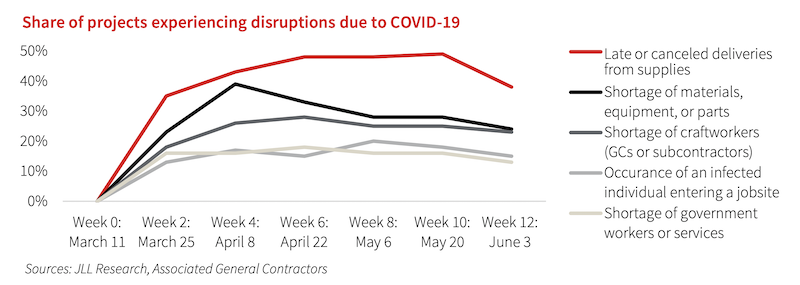
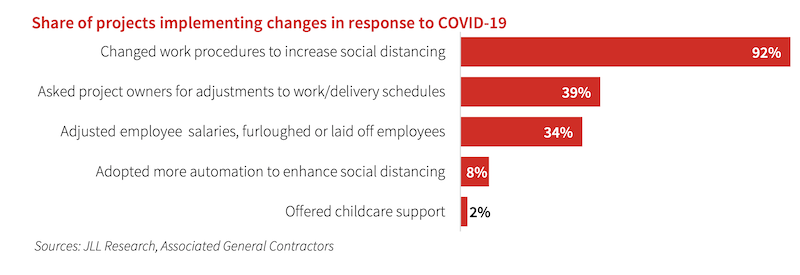
Jobsites struggled with social distancing and procurement during the pandemic.
EMPLOYMENT SANK TO ITS NADIR
That money was needed desperately, as the construction sector in April incurred its largest one-month increase in unemployment ever recorded, jumping above 16% and spread across all sectors and job types. A quick bounce-back in employment was a positive development in May and June, with almost half of the jobs lost in the prior two months recovered. Still, while the labor situation was steadier by early July than during the initial impacts of the pandemic, it remained in much worse condition than at any point in the last seven years.
Construction employment levels are expected to be down 5% to 10% for the year, which JLL thinks will drive down average construction costs for the first time since 2010.
Average construction material prices are expected to begin to rebound in the second half of the year, and materials prices at the end of 2020 are expected to be higher than they are today. However, overall construction material prices will remain lower in 2020 than they were in 2019, before the pandemic led to the initial crash.
One silver lining to the weaker labor market has been an easing of the labor shortage that gripped construction over the last five years. The share of contractors reporting difficulty finding skilled workers has fallen to 46% in the second quarter, compared to 61% a year ago.

Construction costs are expected to fall for the first time in a decade.
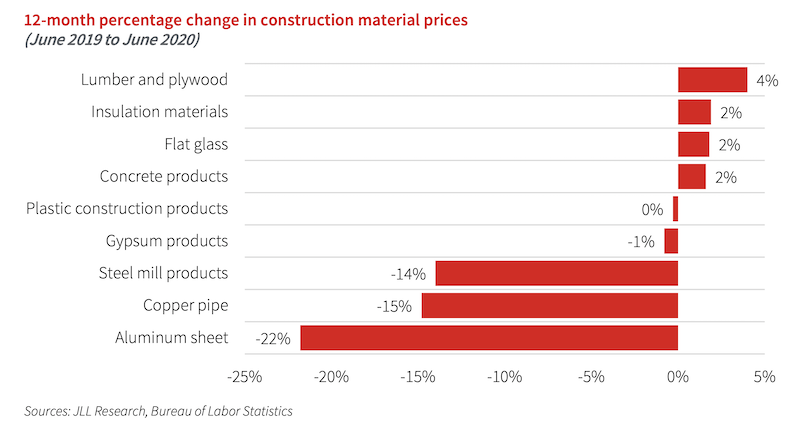
Construction stats are expected to stabilize and remain relatively flat (within plus or minus 5% growth) from Q3 2020 to Q3 2021. The decline in costs will partially be a factor of flat labor costs and temporarily lower materials prices. However, the primary driver for lower costs will be more aggressive bidding. Longer term (Q3 2021 – Q2 2022), the overall industry is expected to shift back to between 2% and 4% growth, with spending, employment, backlog, and costs all rising.
SIX FACTORS THAT COULD IMPACT 2021
JLL’s report offers six forecasts that it believes will reshape the industry into next year:
•These start with the prediction that COVID-19 will continue to challenge construction operations for the rest of this year, and the risk of renewed shutdowns remains possible.
•JLL cites a recent survey by the National League of Cities which found that 65% of cities have already canceled or delayed capital expenditures for infrastructure investments, due to budget shortfalls. Therefore, cutbacks in state and local budgets will create a major risk for construction, especially since public spending had been the primary growth driver over the past two years.
•Since July, U.S. Senate has had the Moving Forward Act, which the House of Representatives already passed. This large-scale infrastructure investment bill, if enacted, would funnel more than $1.5 trillion to roads, schools, hospitals and other public sector projects. JLL states that the upcoming 2020 election creates political risk and uncertainty, with the potential for both positive and negative outcomes for construction regardless of which party wins.
•Construction confidence will remain negative through the end of the year, even as the difference in sentiment between sectors will be even wider than it was pre-pandemic. One change to note is the large drop in sentiment for the hospitals and healthcare sector, which reflects the longer-term challenges in that industry due to the pandemic.
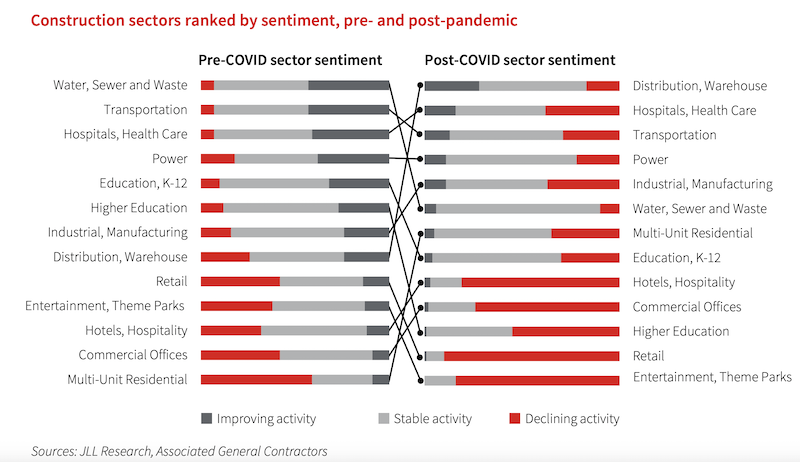
Construction sentiment about the future could take a while to recover.
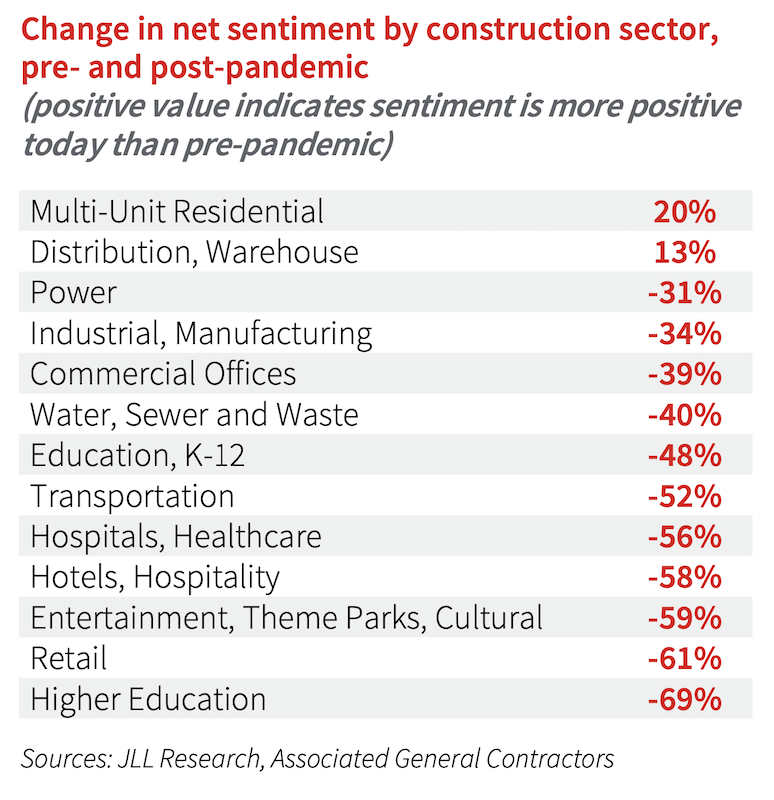
•In addition, long-term construction sentiment is positive for the first time since 2014, and optimism for growth in 2022– 2025 will remain much higher than it was before the coronavirus recession. The share of architecture firms that expect industry prospects to improve in three years jumped to 67% in a recent survey, up from 20% in the fourth quarter of 2019, before the pandemic. For general contractors, sentiment that the industry will improve now stands at 62%, up from 10% at the end of last year.
•The pandemic is leading to a permanent and industry-wide embrace of construction technology. “New health and safety requirements created a whole new class of problems for technology to solve, from health monitoring to contact tracing. An already burgeoning construction tech industry saw a jump in immediate demand,” writes Henry D’Esposito, the report’s author and JLL Americas Research’s Construction Research Lead.
Some of the sectors of construction tech expected to benefit the most will be digital collaboration tools, construction wearables, and offsite construction methods, which should provide both immediate benefits in the coronavirus environment and consistent payoffs once the pandemic is resolved.
Related Stories
Market Data | Nov 27, 2023
Number of employees returning to the office varies significantly by city
While the return-to-the-office trend is felt across the country, the percentage of employees moving back to their offices varies significantly according to geography, according to Eptura’s Q3 Workplace Index.
Market Data | Nov 14, 2023
The average U.S. contractor has 8.4 months worth of construction work in the pipeline, as of September 2023
Associated Builders and Contractors reported that its Construction Backlog Indicator declined to 8.4 months in October from 9.0 months in September, according to an ABC member survey conducted from Oct. 19 to Nov. 2. The reading is down 0.4 months from October 2022. Backlog now stands at its lowest level since the first quarter of 2022.
Multifamily Housing | Nov 9, 2023
Multifamily project completions forecast to slow starting 2026
Yardi Matrix has released its Q4 2023 Multifamily Supply Forecast, emphasizing a short-term spike and plateau of new construction.
Contractors | Nov 1, 2023
Nonresidential construction spending increases for the 16th straight month, in September 2023
National nonresidential construction spending increased 0.3% in September, according to an Associated Builders and Contractors analysis of data published today by the U.S. Census Bureau. On a seasonally adjusted annualized basis, nonresidential spending totaled $1.1 trillion.
Market Data | Oct 23, 2023
New data finds that the majority of renters are cost-burdened
The most recent data derived from the 2022 Census American Community Survey reveals that the proportion of American renters facing housing cost burdens has reached its highest point since 2012, undoing the progress made in the ten years leading up to the pandemic.
Contractors | Oct 19, 2023
Crane Index indicates slowing private-sector construction
Private-sector construction in major North American cities is slowing, according to the latest RLB Crane Index. The number of tower cranes in use declined 10% since the first quarter of 2023. The index, compiled by consulting firm Rider Levett Bucknall (RLB), found that only two of 14 cities—Boston and Toronto—saw increased crane counts.
Market Data | Oct 2, 2023
Nonresidential construction spending rises 0.4% in August 2023, led by manufacturing and public works sectors
National nonresidential construction spending increased 0.4% in August, according to an Associated Builders and Contractors analysis of data published today by the U.S. Census Bureau. On a seasonally adjusted annualized basis, nonresidential spending totaled $1.09 trillion.
Giants 400 | Sep 28, 2023
Top 100 University Building Construction Firms for 2023
Turner Construction, Whiting-Turner Contracting Co., STO Building Group, Suffolk Construction, and Skanska USA top BD+C's ranking of the nation's largest university sector contractors and construction management firms for 2023, as reported in Building Design+Construction's 2023 Giants 400 Report. Note: This ranking includes revenue for all university/college-related buildings except student residence halls, sports/recreation facilities, laboratories, S+T-related buildings, parking facilities, and performing arts centers (revenue for those buildings are reported in their respective Giants 400 ranking).
Construction Costs | Sep 28, 2023
U.S. construction market moves toward building material price stabilization
The newly released Quarterly Construction Cost Insights Report for Q3 2023 from Gordian reveals material costs remain high compared to prior years, but there is a move towards price stabilization for building and construction materials after years of significant fluctuations. In this report, top industry experts from Gordian, as well as from Gilbane, McCarthy Building Companies, and DPR Construction weigh in on the overall trends seen for construction material costs, and offer innovative solutions to navigate this terrain.
Data Centers | Sep 21, 2023
North American data center construction rises 25% to record high in first half of 2023, driven by growth of artificial intelligence
CBRE’s latest North American Data Center Trends Report found there is 2,287.6 megawatts (MW) of data center supply currently under construction in primary markets, reaching a new all-time high with more than 70% already preleased.

















